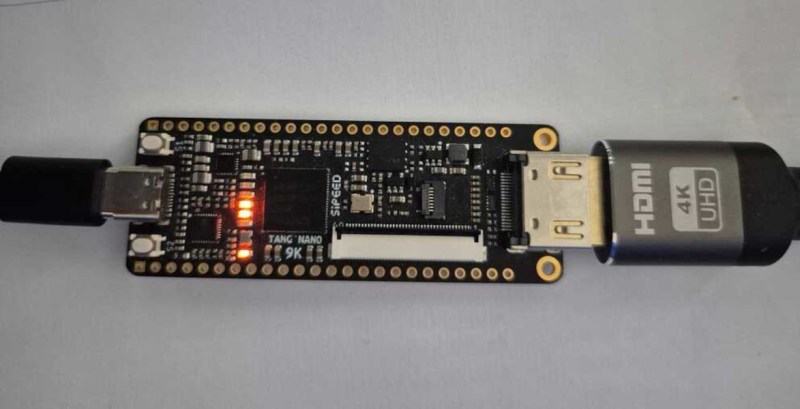When it comes to getting retro hardware running again, there are many approaches. On one hand, the easiest path could be to emulate the hardware on something modern, using nothing but software to bring it back to life. On the other, many prefer to restore the original hardware itself and make sure everything is exactly as it was when it was new. A middle way exists, though, thanks to the widespread adoption of FPGAs which allow for programmable hardware emulation and [Jo] has come up with a new implementation of the Commodore 64 by taking this path.
The project is called the VIC64-T9K and is meant as a proof-of-concept that can run the Commodore 64’s VIC-II video chip alongside a 6502 CPU on the inexpensive Tang Nano 9k FPGA. Taking inspiration from the C64_MiSTer project, another FPGA implementation of the C64 based on the DE10-Nano FPGA, it doesn’t implement everything an original Commodore system would have had, but it does provide most of the core hardware needed to run a system. The project supports HDMI video with a custom kernel, and [Jo] has used it to get a few demos running including sprite animations.
Built with a mix of Verilog and VHDL, it was designed as a learning tool for [Jo] to experiment with the retro hardware, and also brings a more affordable FPGA board to the table for Commodore enthusiasts. If you’re in the market for something with more of the original look and feel of the Commodore 64, though, this project uses the original case and keyboard while still using an FPGA recreation for the core of the computer.
















There are more FPGA cores on Tang 9k : https://github.com/harbaum
Indeed a great resource for Tang Nano cores. The HDMI adaptation origins from their. AFAIK their cores are 20k+ though. https://github.com/vossstef/VIC20Nano
supports the 9k.
A neat project.
The great Jeri Ellsworth did something similar about 20 years ago: https://en.wikipedia.org/wiki/C64_Direct-to-TV but I think with an actual ASIC and not a FPGA.
The DTV2 (EU) was very feature complete, also.
Most pins of User port, module port, datasette etc. were available as solder pins.
The joystick design was more of a decoy, really – the designers really tried to bring back a fully functional C64 that can be mass-produced.
That’s also why many C64 fans put the PCB in a little box and added real DE9 connectors.
Imagine how great it would be if C64 replacement motherboards (full size) with that ASIC could be sold today.
It would be very cheap in production and be a fine alternative to those who need a new, 99% hardware-based motherboard
or justv want to assemble a whole C64 from a kit.
Would make for a great father-son/grandfather-grandson project, maybe.
Sure, the C64 die-hards would stick to their 80s hardware and use real SIDs etc. That’s okay.
These guys wouldn’t touch any aftermarket motherboard anyway, so no harm would be done.
Such an one-chip C64 motherboard would simply be a modern, more or less authentic alternative that exists.
Because the original hardware won’t last forever and even parallel RAMs and ROMs are now oldschool as such.
now that Commodore is being revived and Jeri Ellsworth is part of that along with quite a few original Commodore staff that is very much on the cards, see perifractics new video on the subject.
Although the C64DTV was very complete in the additional features it offered, like the additional joystick, keyboard and IEC-serial lines. I never heard or seen about the userport or datasette port signal being available. I’ve owned a C64 DTV, modded it into a diskdrive and would have loved to have to add a datasette connector to it.
Hi there! Good point. The DTV1 didn’t have it, apparently. :(
The C64 Wiki mentions that it was added in DTV2.
https://www.c64-wiki.de/wiki/C64DTV
I’d love to know how close the SID was, and, given Jeri seems to be involved with the “new” commodore, if they could be persuaded to license or even manufacture some new versions of the old custom silicon
You’re probably not going to see individual C64 chips made in full custom… They’re basically too small to make sense, when an FPGA will do the job. There do seem to be a whole mess of individual FPGA chip replacements out for Amiga system chips, so it’s definitely possible if anyone has the interest.
She also made a feature-complete Amiga on a chip, but the project was cancelled. You can find her video about it on YouTube.
I would love a complete Amiga on a chip. It was my first real computer. I dont count the Texas Instraments TI-99/4A, lol.
I wonder how much C-One DNA was in the DTV… 😏
Jens at iComp.de has been selling an FPGA C64 in Cartridge form for years,
He and Jeri even did a FPGA board together, the C-One, but from what Jens told us Jeri went back to the USA with all documentation and code and did the DTV, of which Jens never saw a cent.
Don’t forget that the new FPGA based Sinclair ZX Spectrum Next has a Commodore 64 core!
Tang Nano 9k is the board, from Sipeed. The FPGA is from Anlogic.
The FPGA is from GOWIN
Funny how they now put 4K | UHD on HDMI cables when they actually mean it’s HDMI 1.4b. A thing they started when HDMI 2.x was introduced.
I wonder what they’ll put on HDMI 2.x cables once HDMI 3.0 is out, 8K | S-UHD probly eh.
Either way, once you know you know.
Strange to not mention here that there is an upcoming official FPGA-based Commodore 64? https://www.commodore.net/